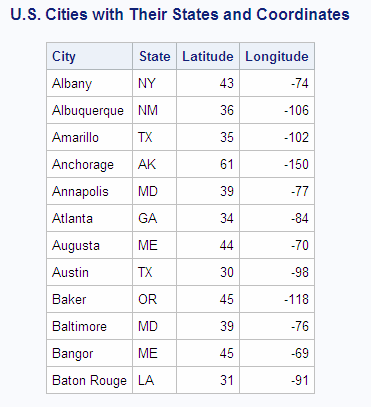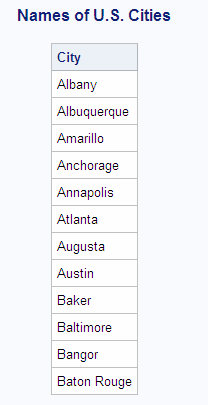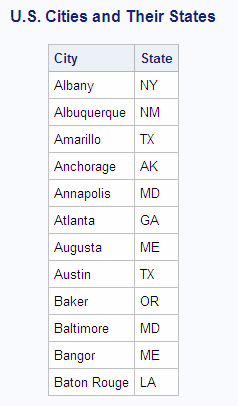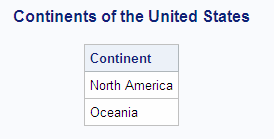Selecting Columns in a Table
When you retrieve data from a table, you can select
one or more columns by using variations of the basic SELECT statement.
Selecting All Columns in a Table
Use an
asterisk in the SELECT clause to select all columns in a table. The
following example selects all columns in the SQL.USCITYCOORDS table,
which contains latitude and longitude values for U.S. cities:
libname sql 'SAS-library';
proc sql outobs=12;
title 'U.S. Cities with Their States and Coordinates';
select *
from sql.uscitycoords;Note: The OUTOBS= option limits
the number of rows (observations) in the output. OUTOBS= is similar
to the OBS= data set option. OUTOBS= is used throughout this document
to limit the number of rows that are displayed in examples.
Selecting Specific Columns in a Table
To select a specific column in a table, list the name
of the column in the SELECT clause. The following example selects
only the City column in the SQL.USCITYCOORDS table:
libname sql 'SAS-library';
proc sql outobs=12;
title 'Names of U.S. Cities';
select City
from sql.uscitycoords;If you want to select
more than one column, then you must separate the names of the columns
with commas, as in this example, which selects the City and State
columns in the SQL.USCITYCOORDS table:
Eliminating Duplicate Rows from the Query Results
In some
cases, you might want to find only the unique values in a column.
For example, if you want to find the unique continents in which U.S.
states are located, then you might begin by constructing the following
query:
libname sql 'SAS-library';
proc sql outobs=12;
title 'Continents of the United States';
select Continent
from sql.unitedstates;You can eliminate the
duplicate rows from the results by using the DISTINCT keyword in the
SELECT clause. Compare the previous example with the following query,
which uses the DISTINCT keyword to produce a single row of output
for each continent that is in the SQL.UNITEDSTATES table:
Determining the Structure of a Table
To obtain
a list of all of the columns in a table and their attributes, you
can use the DESCRIBE TABLE statement. The following example generates
a description of the SQL.UNITEDSTATES table. PROC SQL writes the description
to the log.
Determining the Structure of a Table (Partial Log)
NOTE: SQL table SQL.UNITEDSTATES was created like: create table SQL.UNITEDSTATES( bufsize=12288 ) ( Name char(35) format=$35. informat=$35. label='Name', Capital char(35) format=$35. informat=$35. label='Capital', Population num format=BEST8. informat=BEST8. label='Population', Area num format=BEST8. informat=BEST8., Continent char(35) format=$35. informat=$35. label='Continent', Statehood num );
Copyright © SAS Institute Inc. All rights reserved.




